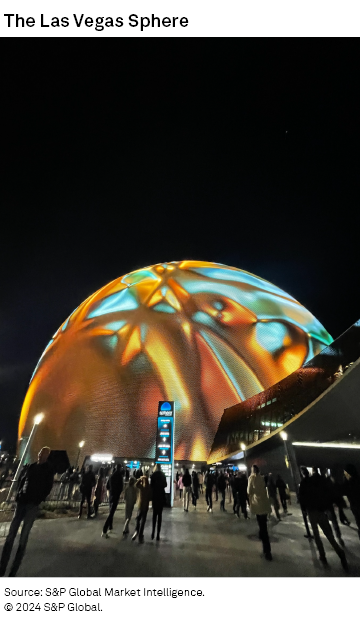Featured Topics
Featured Products
Events
S&P Global Offerings
Featured Topics
Featured Products
Events
S&P Global Offerings
Featured Topics
Featured Products
Events
S&P Global Offerings
Featured Topics
Featured Products
Events
Financial and Market intelligence
Fundamental & Alternative Datasets
Government & Defense
Banking & Capital Markets
Economy & Finance
Energy Transition & Sustainability
Technology & Innovation
Podcasts & Newsletters
Financial and Market intelligence
Fundamental & Alternative Datasets
Government & Defense
Banking & Capital Markets
Economy & Finance
Energy Transition & Sustainability
Technology & Innovation
Podcasts & Newsletters
Research — 25 Jan, 2024
By Mike Paxton, Neil Barbour, and Zoe Roth
After being hobbled by the pandemic, CES continued to pick up speed in 2024. Organizers estimated 135,000 attendees poured into Las Vegas for CES 2024, held Jan. 8-12. The head count was up roughly 15% year over year but well below that of 2019, when the show attracted 175,000 visitors.
Booths from the likes of LG Corp., Sony Group Corp. and Samsung Electronics Co. Ltd. were a little bigger and a little busier than in the past few years, even if the show was not quite back to pre-pandemic form.

Key trends spotted by analysts Zoe Roth, Neil Barbour and Mike Paxton included:
– TV vendors are still looking for a high-end edge. LG quickly became the talk of the show with its transparent TVs while Samsung promised, through the power of AI, a better experience for 8K, a resolution that has been starved for content. While most consumers may not see the value of a see-through TV, it offers a "wow" factor in the low-volume, high-margin premium TV market. And it is those premium sales that drive margins in an otherwise commoditized business.
– AI themes were persistent at the show, but often at the margins of other product announcements or as an example of potential future capabilities. For instance, Sharp Corp. offered showgoers a digital assistant driven by AI to answer questions about their business. LG and Samsung showed their AI robot companions as part of larger smart home ecosystems, but those devices were pitched as near-future opportunities rather than imminent releases. In another AI-related announcement, Walmart Inc. used its high-profile keynote address to pitch an upgrade to its In-Home grocery replenishment service. The new feature would use an AI model to order groceries based on a consumer’s past purchasing habits. However, when asked about when the service would be available, a Walmart executive noted that it was still just an idea under development.
– Automotive vendors were tackling the software-defined vehicle (SDV) with the help of their partners. Global OEMs showed out at the event, with notable announcements from Honda Motor Co. Ltd., Volkswagen AG and Mercedes-Benz Group AG articulating their approach to connected cars. Honda showed two EV concept vehicles — the saloon and space-hub — slotted for 2026 release. Volkswagen announced ChatGPT integration into vehicles' intelligent driving assistant through a partnership with Cerence Inc.'s ChatPro offering. In a break from many of the AI announcements at the show, the integration will be available as soon as this year. Mercedes is following a similar path toward in-car generative AI to enhance driver experience and comfort with the unveiling of the MBUX virtual assistant, which will be based on MB.OS.
– The metaverse was also well represented at CES. Along with multiple demos highlighting VR or XR devices, there were numerous sessions discussing future opportunities in the metaverse, with many tying in an AI angle. In perhaps the biggest announcement around the metaverse, Siemens AG said it was partnering with Sony, Amazon.com Inc. and Microsoft Corp. to grow the industrial metaverse.

– Smart glasses reemerged. Apple Inc. preempted the show by announcing the ship date for its Apple Vision pro (Feb. 2) in abstention, which created a tailwind for the AR/VR hardware vendors at the show. Surprisingly, many of those vendors were not showing souped-up helmets to match the processing power of Apple, but rather pulling the possibility of "spatial computing" into the eyeglass-size devices. While Shenzhen Tairuo Technology Co. Ltd.'s XREAL Air 2 Ultra AR and TCL Electronics (Huizhou) Co. Ltd.'s RayNeo X2 may not be as capable as the $3,500 Vision Pro, they both represent significant leaps forward in the smart glasses segment.
– As EV adoption grows, mapping providers and OEMs alike are looking to enhance real-time charger availability and insights. TomTom NV and Here Technologies were among mapping providers serving the opportunity, with many of their OEM customers building their own, white labeling the platform to mitigate range and charging anxiety.
– Sustainability in general was a hot topic at the show, with "green tech" being a key buzzword. Exhibits ranging from EVs to next-generation battery products to smart home energy management platforms were a common sight.
Technology is a regular feature from S&P Global Market Intelligence Kagan.
This article was published by S&P Global Market Intelligence and not by S&P Global Ratings, which is a separately managed division of S&P Global.